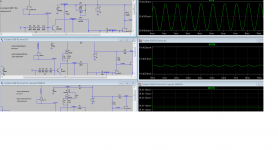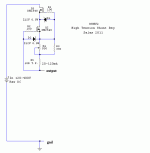Ironically, LOMC builds would benefit the most from CCS vs R13, but also are the most susceptible to noise issues. Configurations where the current noise of the CCS is insignificant are also unlikely to benefit from the CCS.
This CCS thing (R13 mod) interests me principally because it renders operations indifferent to PSU wonderings.
Now I would really appreciate your input on the best, stiffer and lowest noise CCS possible in this case.
Now I would really appreciate your input on the best, stiffer and lowest noise CCS possible in this case.
Ciao Orelli, now SE but due to the high SQ I'm thinking to go balanced in the future.
Grande!
Hi Salas, I'm building a balanced one with one 369 for 56 dB gain and I'm intrigued by the possibility to use a CCS in R13 position. You suggest a Supertex DN2540 ( ...and I get a lot of them), but I have a single 369 and I need only 9mA, not 18. Can I use a K170 with the same Idss , tying G and S and connect it in the R13 position? IMHO ccs bring always a great sense of air and musicality over the simple resistor polarisation... and remain a simplistic thing.
If it can handle the dissipation in the long term (there will be high VDS), maybe use a TO-92 sink, you can try it. It will inject some own noise too but you may not object. The Supertex is not doing a good job if asked for less than about 20mA anyway.
Salas I use two 369, could I use DN2540 as CCS, if yes with CCS circuit is better and why: one or two DN2540?
Merlin
Please take a look at my simulations. (R13 is replaced by a CCS with a trimmer in the fet source)
The idea is to fix the idling current on the input fets so we do not need to wait until all voltages stabilize in order to have optimal behavior.
If you find a suitable supplier for the DN2540, I am interested.
Please take a look at my simulations. (R13 is replaced by a CCS with a trimmer in the fet source)
The idea is to fix the idling current on the input fets so we do not need to wait until all voltages stabilize in order to have optimal behavior.
If you find a suitable supplier for the DN2540, I am interested.
A Balanced riaa based on two boards per channel might be really difficult to achieve because in each channel we would need two exactly equal amps with the same amplification and the same riaa curve. Due to parts variations I believe it to be a task for Zeus.
IMO if one needs a balanced output, better is to use a TX or an opamp.
IMO if one needs a balanced output, better is to use a TX or an opamp.
Ricardo if you want I can share my order to RS.
Thank you Merlin but I needed some other parts and profited to use RS as a provider.
I will have those soon 🙂
No problem Ricardo, you will use two DN2540 as CCS or only one? What are the benefits to use two in place of one DN2540?
Two mosfets form a cascode where the top one keeps collector voltage steady on the lower one.
Impedance is much higher and CCS is much more stiff.
Anyway I must try one mosfet only in the first place and see if it does not inject too much noise in the system.
If only one works I might try to cascade in a later stage 🙂
Impedance is much higher and CCS is much more stiff.
Anyway I must try one mosfet only in the first place and see if it does not inject too much noise in the system.
If only one works I might try to cascade in a later stage 🙂
As you can see, with the resistor ccs, current swings freely with signal (top circuit)
Using an active ccs with one DN2540, current swing is greatly reduced (mid circuit)
Using a cascaded ccs with two DN2540, simulation does not predict oscilation (bottom circuit)
But active ccs might prove too noisy for powering the folded input stage.
Anyway this is a good opportunity to experiment.
PS: current setting will be done with a trimmer in the mosfet source (R20) in my schematic.
Using an active ccs with one DN2540, current swing is greatly reduced (mid circuit)
Using a cascaded ccs with two DN2540, simulation does not predict oscilation (bottom circuit)
But active ccs might prove too noisy for powering the folded input stage.
Anyway this is a good opportunity to experiment.
PS: current setting will be done with a trimmer in the mosfet source (R20) in my schematic.
Attachments
I use only one DN2540 in my #26 preamp.
What is your #26 preamp ?
A Balanced riaa based on two boards per channel might be really difficult to achieve because in each channel we would need two exactly equal amps with the same amplification and the same riaa curve. Due to parts variations I believe it to be a task for Zeus.
IMO if one needs a balanced output, better is to use a TX or an opamp.
don't be afraid of the components matching, a balanced version wins low hands in
s/n ratio, air, dinamic and soundstage. I've tried it with the old version and I was VERY satysfied. If there was a little error in the frequency response, the
greater musicality will forget it.
For loading the plate on this tube I would use the cascaded version of the ccs and pick up signal from the low impedance node (gate of the upper mosfet)
That way you will maximize gain and linearity.
Post on the 26 thread and I will explain better there.
don't be afraid of the components matching, a balanced version wins low hands in
s/n ratio, air, dinamic and soundstage. I've tried it with the old version and I was VERY satysfied. If there was a little error in the frequency response, the
greater musicality will forget it.
I am a perfectionist and know that a minor freq difference between channels introduces phase issues between channels that kill the soundstage credibility.
Now imagine the same if both lines of the same channel in a balanced configuration get different freq response with different gains.....
In a balanced config, even the cables impedance if of paramout importance in both signal lines.
MTC off course.
For loading the plate on this tube I would use the cascaded version of the ccs and pick up signal from the low impedance node (gate of the upper mosfet)
That way you will maximize gain and linearity.
Post on the 26 thread and I will explain better there.
Like the CCS of SSHV2?
Attachments
I believe so... I did not study that Salas circuit and he calls it a shunt reg...
But the idea is to load the plate with a stiff ccs like here: Mono and Stereo High-End Audio Magazine: DN2540 High Voltage Constant Current Source
But the idea is to load the plate with a stiff ccs like here: Mono and Stereo High-End Audio Magazine: DN2540 High Voltage Constant Current Source
- Home
- Source & Line
- Analogue Source
- Simplistic NJFET RIAA

